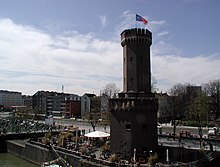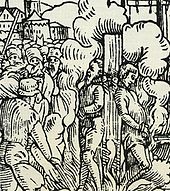Arnold von Siegen

Arnold von Siegen (* around 1500 in Cologne , † January 8, 1579 in Cologne) was a councilor and mayor of Cologne in the early modern period. He was also imperial councilor and was knighted .
Live and act
Parental home and environment
Arnold (Arndt) von Siegen was the son of the Cologne councilor Gerhard von Siegen. His parents' house was in the southern suburb of Cologne on the Holzmarkt on the banks of the Rhine and belonging to the Johann Baptist parish . The market, (forum lignorum) called "houltzmart", was the storage place for all kinds of goods, as was the trading place of the "Holzmerger" (traders). Here was the home of Gerhard , who then probably the most in the adjacent neighborhood Bach upwards on Waidmarkt met dwelling daughter of a wealthy wool and cloth dyer and married them. Gerhard's marriage had several children. Since Gerhard von Siegen already belonged to the upper middle class and Gerhard's wife brought a considerable dowry into the marriage, it can be assumed that all children raised in a strictly Catholic manner received a very good education. This, and the reputation of his father, laid the foundation for the career of the young Arnold von Siegen.
Political activity
Arnold von Siegen was elected mayor of his hometown twelve times . He also repeatedly held the office of rent master and was appointed provisional at the old University of Cologne .
Hermann von Weinsberg , one of the councilors, described "Arnold" in his memorial book as a person with a winning character and praised his "fine eloquence". These qualities, coupled with a dexterous demeanor, made him popular among his fellow councilors and earned him the role of urban negotiator at an early stage. So he was often sent to the imperial court, to imperial and city days as their confidant. In 1526 he was Cologne's representative at the Reichstag in Speyer , where he signed a memorandum for the city , which was intended to mediate the religious differences among the imperial cities. He was also a member of a delegation to Spain , which was supposed to inform the Emperor Karl about the state of church affairs in Germany. On this occasion Siegen reaffirmed the strict Catholic position of the Cologne council and thereby won the confidence of the emperor, who later knighted him and appointed him to his council . In this distinctive position he remained under Charles' successor, King Ferdinand .
Reformation time
Since 1525 the Lutheran Reformation had lost its importance as a popular movement and had become a regional matter for the sovereigns. The city, which is often at odds with the clergy, however, complied with the church on matters of faith. Arnold von Siegen also endeavored to maintain Cologne's Catholic attitude. It was also he who resolutely opposed the first signs of Protestantism in his hometown and took an active part in the trial of the Protestants Adolf Clarenbach and Peter Fliesteden, who were then executed in 1529 . In 1532 at the Reichstag in Regensburg he made derogatory comments about the inner strength of the Lutheran movement:
"Some Lutherans would like to return to the old faith because the Reformation has become a revolution"
Siegen also demanded that the council, in order to appease the emperor's discontent, that tough measures be taken against sectarians . Siegen remained faithful to this principle throughout his long political career.
When Archbishop Hermann V von Wied wanted to carry out the reformation of the Cologne diocese , Siegen stood on the side of the clergy who rebelled against it and, as a representative of the city of Cologne, joined their protest and objection. In the spring of 1546 the archbishop was suspended and excommunicated .
resignation
To the astonishment of all, Siegen resigned from his offices around 1564 as a still vigorous man for his age and renounced the citizen oath . The reason for his resignation may have been the unsteady attitude of the council on the religious question, which he did not like, or because the council had refused a personal request. Ennen concluded from his research that both points only contributed to Siegen's decision. The main reason, Ennen continued, was to be found in the fact that Siegen saw his material interests seriously damaged. Siegen, caused by the reprisals which the Brabant government had taken in a dispute with the Cologne state, was blocked by citizens of Cologne.
Retirement
Siegen lived in family seclusion for 15 years until his death in 1579. He was now an independent citizen who had made a substantial fortune with his family. He expanded his father's house on the Holzmarkt into a splendid property with towers, which was one of the sights of Cologne at the time. The von Siegen had high personalities like 'Karl V.' and other princely gentlemen as guests, whose customs, as they were customary at court, were adopted in the von Siegen house. Various large estates also belonged to the property. 'Weinsberg' reports that Siegen's fortune was estimated at 100,000 guilders . Like other wealthy Cologne mayors (e.g. Gerhard Ungemaze, Johann von Rinck ), Arnold von Brauweiler , von Siegen also gave the elector large loans.
Siegen's legacy
Siegen's pious disposition was also evident in his charity towards his parish church dedicated to St. John the Baptist. For this he took over the costs of an extensive expansion and decoration, as well as the endowment of the pastor's office and a large charitable foundation. He donated an altar to the church, the wings of which had been painted by Barthel Bruyn . At the request of the client, Arnold von Siegen and his wife were shown kneeling among the people portrayed by Bruyn. These pictures are in the Boisseréeschen collection in the Alte Pinakothek in Munich.
After the death of the head of the family, the majority of his descendants decided to convert to Protestantism. The house on the Holzmarkt was closed by the council in 1591 because of an unauthorized secret Protestant gathering. At the end of the 17th century it was converted into a large poor house for the city of Cologne. Today a fountain in front of the church "Zint Jan" (St. Johann Baptist), created in 1966 by the artist Elisabeth Baumeister-Bühler , as well as the naming of a small residential street behind the church of St. Johan Baptist, reminds of one of the Cologne mayor most influential mayor of the 16th century.
Literature and Sources
- Adam Wrede : New Cologne vocabulary . 3 volumes A – Z, Greven Verlag, Cologne, 9th edition 1984, ISBN 3-7743-0155-7
- Carl Dietmar: Die Chronik Kölns , Chronik Verlag, Dortmund 1991, ISBN 3-611-00193-7
- Hermann von Weinsberg : Liber Senectutis
- Online offer: Historical archive of the city of Cologne
- Wolfgang Herborn: On the reconstruction and edition of the Cologne mayor list up to the end of the Ancien Regime , in: Rheinische Vierteljahresblätter 36 (1972)
- Leonard Ennen , Gottfried Eckertz: Sources for the history of the city of Cologne 6 volumes, Cologne 1863/79
- Leonard Ennen, History of the City of Cologne IV. Cologne and Neuss 1875
- Stein: The family v. Victories in Cologne in the annals of the historical association for the Lower Rhine 35 (Cologne 1880) 17. ff.
- FEA Krause: The origin of the von Siegen family in Dorsten , in Vestische Zeitschrift 42 (1935) 12 ff.
- Councilor directory of Cologne during the imperial city period from 1396–1796 , with genealogical additions by Herbert M. Schleicher, Cologne 1982
Individual evidence
- ↑ Wolfgang Herborn, List of Cologne Mayors
- ^ Adam Wrede, Volume I, p. 362
- ^ Hermann von Weinsberg, Liber Senectutis
| personal data | |
|---|---|
| SURNAME | Siegen, Arnold von |
| ALTERNATIVE NAMES | Siegen, Arndt von |
| BRIEF DESCRIPTION | Councilor and Mayor of Cologne in the early modern period |
| DATE OF BIRTH | around 1500 |
| PLACE OF BIRTH | Cologne |
| DATE OF DEATH | January 8, 1579 |
| Place of death | Cologne |




